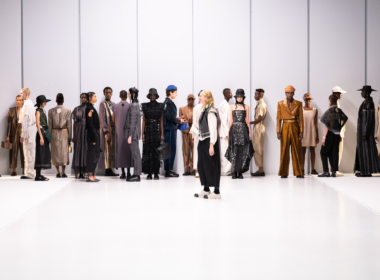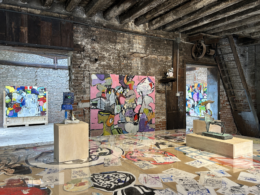It Takes More Than Painting to Be an Artist
Ayoola Omovo is an abstract art painter with a degree in Fine and Applied Art. Offering viewers a departure from the usual vibrant colours of most artworks, Ayoola uses black and white in her paintings to create a unique and distinct effect. In this interview with FABL’Style, Ayoola Omovo speaks about her unique style, her experiences as a female artist, her contribution to empowering women in society, and the deeper significance of art in our society.
We should see beyond tagging artists as being rough, rugged, or not intelligent.
Ayoola Omovo
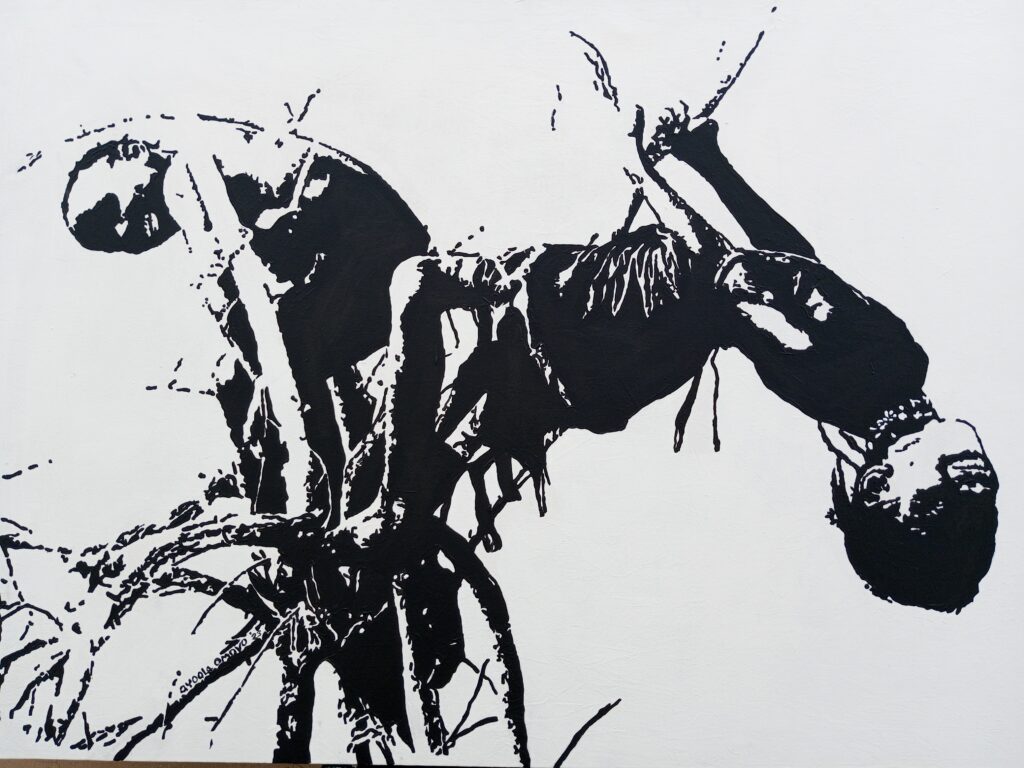
FAB: What’s your story? How did you discover this particular technique (black and white)? What draws you to its expressive potential?
AYOOLA OMOVO: I graduated from the University of Benin, and I had a lecturer named Mr. Bardi. He taught us ‘trams’. ‘Trams’ is the use of black and white to tell a story from a picture. When I graduated from the university, I discovered that art is vast, with plenty of active space. I pondered how to create something unique and differentiate myself. So, I revisited the trams. Instead of incorporating more colours, I decided to execute the paintings in black and white to explore their potential.
Initially, I experimented with ink, and though it resembled photography, people gradually accepted it. I thought to myself, “I’ll take you back to the olden days when the TV was black and white, and we still enjoyed it.” Over time, I honed my skills. There’s something compelling about black and white that makes it stand out. At exhibitions, it grabs people’s attention, prompting them to inquire about the artist. When I reveal myself, they question my choice of black and white and whether I can paint in colour. My response? “That’s why you called me out. If the painting were in colour, you wouldn’t have noticed me or my work.” This distinction has given me an edge over other artists.
Black symbolises strength, and white symbolises life; where there’s life, there’s hope. The touch of gold in my work signifies achievement. While some are strictly black-and-white, my recent works incorporate gold. It signifies patience in achieving certain things, especially in the male-dominated field of art.
There’s an assumption that once I get married, I won’t be able to continue, or that when I start a family, my creativity will cease. But I’m determined to disprove that. This is my calling; I speak my own language through my art. It’s my voice and my means of communication. If the deaf can see the painting and comprehend, then I’ve conveyed a message. That’s why I adopted black and white. It’s gratifying that people can immediately recognise my work as mine. It fuels my joy and propels me forward. Women deserve recognition; they should wield more power and authority because of their inherent passion and commitment. When a woman leads, she does so with conscientiousness, striving to include others. This narrative underlies every piece of my work. We can achieve; we are resilient. When there’s life, there’s progress. Events will unfold.
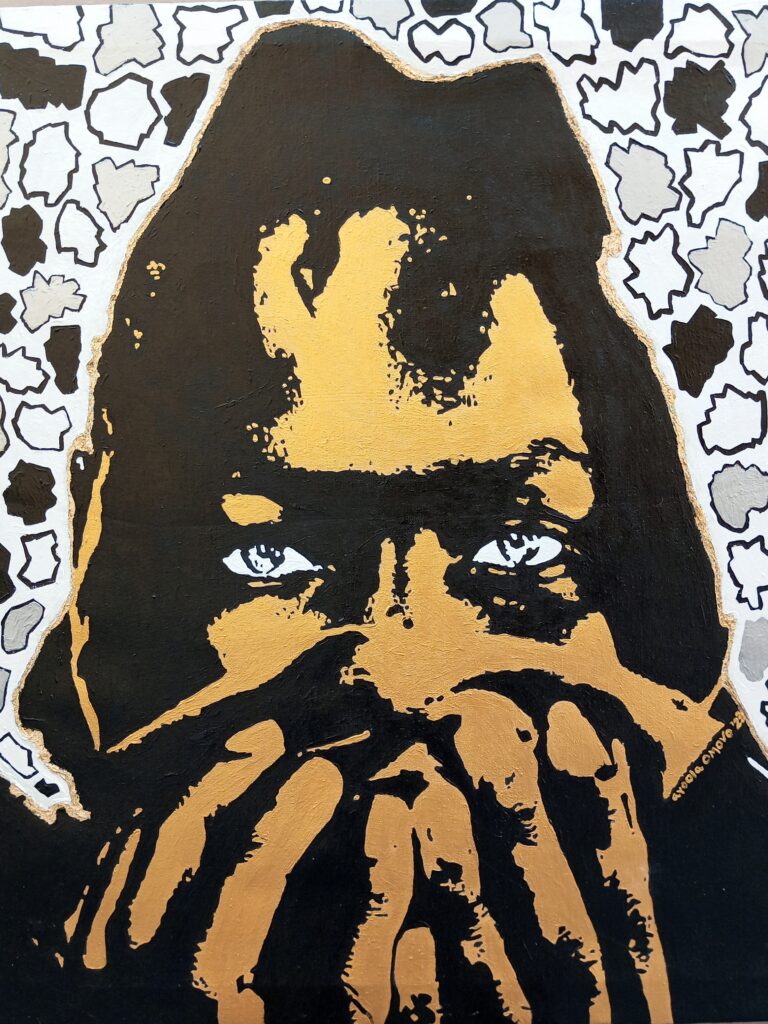
FAB: What’s your take on how Nigerians view art?
AYOOLA OMOVO: Here in Nigeria, we are gradually recognising the value of art. If you put fashion, food products, and art together, many would go for the fashion. After food, people go for looks. They want to look elegant and African. A lot of them would say art is not food; some think art is fetish. They don’t know the essence or the value, probably because they are not very educated about art. The information has not really gone around; only a few know the value of art and what art speaks.
When we did our art in the hospital, I had the opportunity to paint a children’s ward in LUTH. When we got there, everything was dull. There was a need to paint the place. We went in with another guest artist from Florida and painted the place. We made it a rainbow room. We put in some colours, and we created a room for them where they go in for their injections and treatments.

We made a place for them to practice art because we wanted the children to forget their pain, to feel at home, and not cry. When they come into the room, you see the smile on their faces. Before you know it, the nurse comes to give them the injection, and they go back to the centre to work on their art. People now see that art can heal and that art is therapeutic. Even in mental health, art calms people.
People need to know that art is very valuable. It goes beyond just drawing and painting and hanging it in my house. It also regulates other sectors. Collectors now go abroad to verify the value of artworks and see their worth as collectors. They like African contemporary art; they want it and are more aware of it. Art creates awareness, passes information, and gives people an idea of certain things they don’t know. Art is our voice. We speak to and relate to people through our arts.

Ayoola Omovo: Business of Art
FAB: You’ve been involved in numerous art associations, including being the vice chairman of the Society of Nigerian Artists, Lagos Chapter. What impact has this association had on educating Nigerians about the value of art in our society and GDP?
AYOOLA OMOVO: We were able to put art on the entrepreneurial scale to let people see that they can be employed and that they can employ people in art. We did this by teaching them what could fetch them money. We educate individuals on various art forms such as painting, textiles, ceramics, sculpture (metal or wood), graphic arts, waste-to-wealth concepts, and more. Art is incredibly versatile. However, some artists create exceptional pieces but lack the know-how to market or conduct business with their art. Hence, our association steps in to bridge this gap by offering guidance on marketing strategies and self-promotion.
We’ve facilitated health insurance for all our members and invited experts to enlighten them on pricing strategies and the protection of their intellectual property. Collaborating with galleries, we organise exhibitions to showcase the work of our young contemporary artists. Sometimes, it’s not only about exhibitions. We also go on tours to see what we can do together with other countries. If Brazilians like the Yoruba culture, what can we inculcate into our own art to let people know that this art is like history? Some people were able to trace their history through the works of art down to Africa. Art is something that everyone needs to have in their homes and offices. There is art all around you. Your spoon, your table cover, your duvet, your curtains—everything about you is art. People need to perceive their surroundings with an artistic lens to truly appreciate their value.
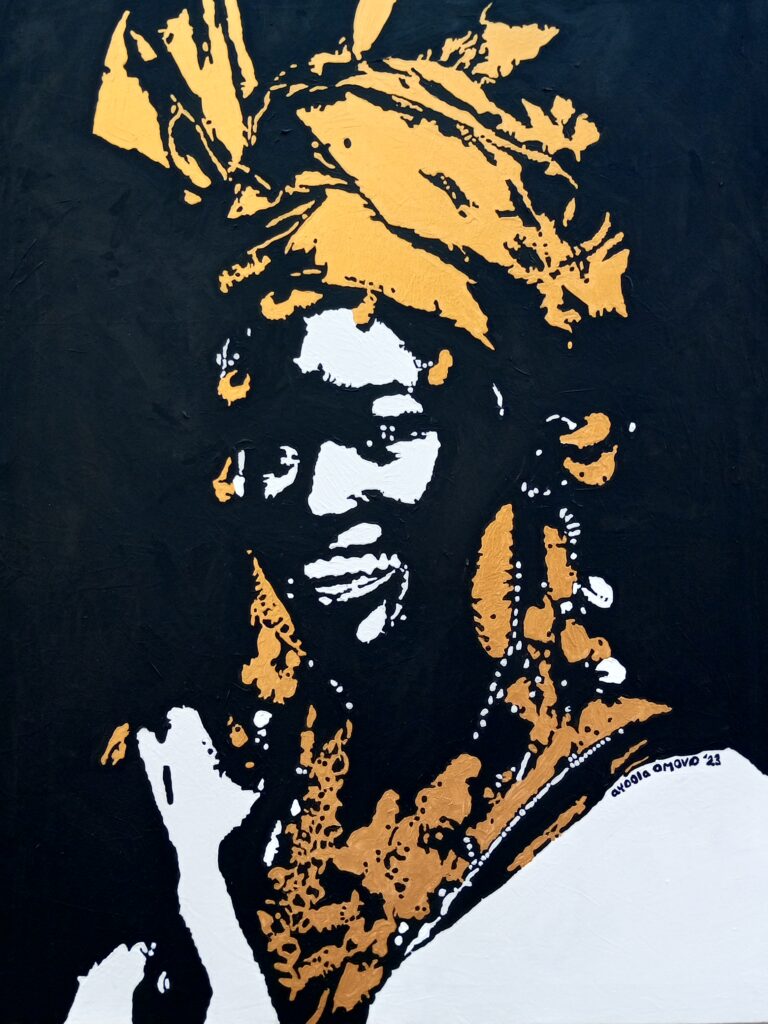
FAB: You’ve participated in events like “Art for Peace” and “Elimination of violence against women and girls.” What prompted your focus on these specific societal issues?
AYOOLA OMOVO: As a woman who was once a girl, I keenly observe the oppression prevalent in Africa. Women are often marginalised, and certain traditions continue to disadvantage them. Inheritance practices favour male children over older female siblings, perpetuating gender bias. Additionally, there’s a prevailing attitude that silences women when men speak. There’s a general failure to acknowledge the significance of women, who are the pillars of future generations. If a girl isn’t educated, how will she educate the next generation? Her upbringing significantly shapes her parenting. We advocate for fair treatment of women. Some believe that a woman’s zenith lies in marriage, relegating her to domestic chores. We implore fathers and brothers to treat women equitably.
Personally, I had an incident at a shopping mall that exemplified the repercussions of baseless assumptions. After getting married, I was in a shopping mall one day, and I saw a master artist. I had invited him to my wedding, but he didn’t come. I went to him, and we hugged and pecked. My husband’s younger sister was there, watching. She saw that and rushed to tell my husband. When we got home and I told my husband who I had seen, he said his sister had told him that I was kissing somebody. That could have caused something in a home where there is no trust. It’s something that we need to speak out about.
These issues need addressing; we must not stifle a woman’s potential. Do not kill that child; don’t enslave her mentally; don’t enslave her in everything. Give her a chance to speak. Give her a chance to be who she wants to be. We aim to empower young women, demonstrating that despite tragedies, they can pursue their aspirations. We mustn’t limit them based on their parental background. Women are pivotal in building generations.
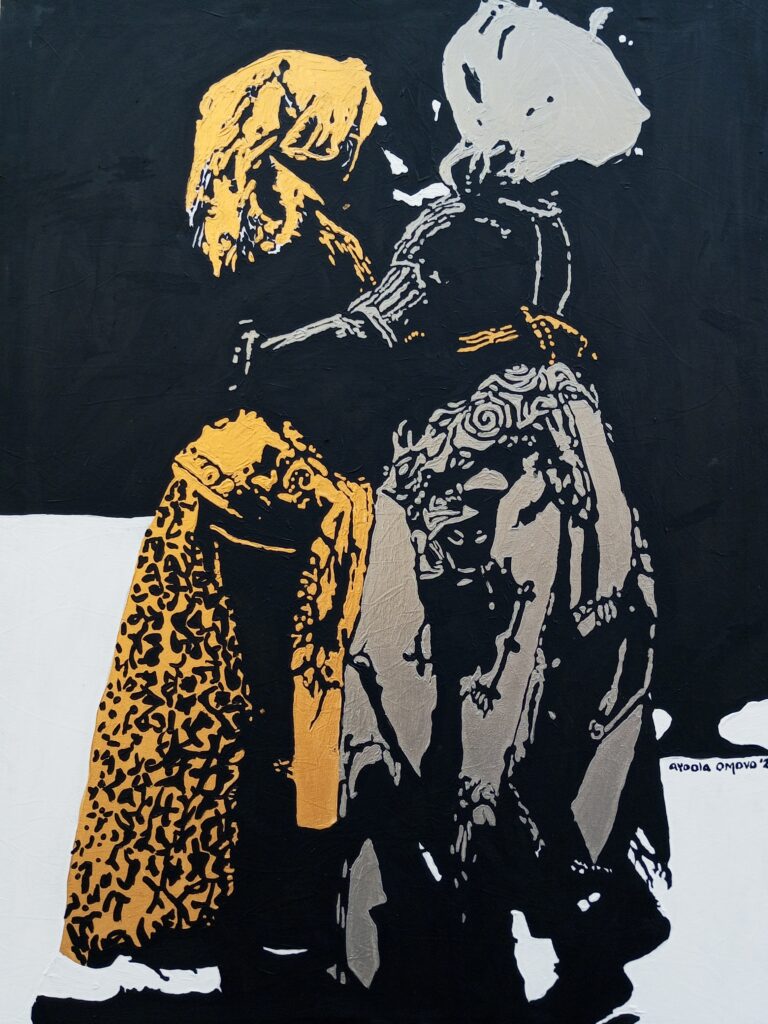
FAB: What inspires you, and what’s your creative routine?
AYOOLA OMOVO: I’m not particularly drawn to music or television. My creative spurts often occur when I’m calm, sometimes while writing. My family background influenced me; although everyone else pursued non-artistic careers, exposure to art broadened our perspectives. My late dad was an engineer, and my brother was a doctor, and he also started from this drawing. He would draw Father Christmas, paint it, and hang it outside. My other brother is also an engineer, and I’m the only person in the family who’s an artist. That’s just to convince you that you should allow your kids to explore art. They might not end up being artists, but it opens their knowledge to the outside world.
When you’re creative or you’re painting, you don’t see things ordinarily. You have a unique perspective on things. As an art teacher, it gives awareness to the kids. When they are out or at home, they are able to identify colours and shapes. After their holidays, when I ask them to paint what it was like for them, I see different expressions. They are able to observe.
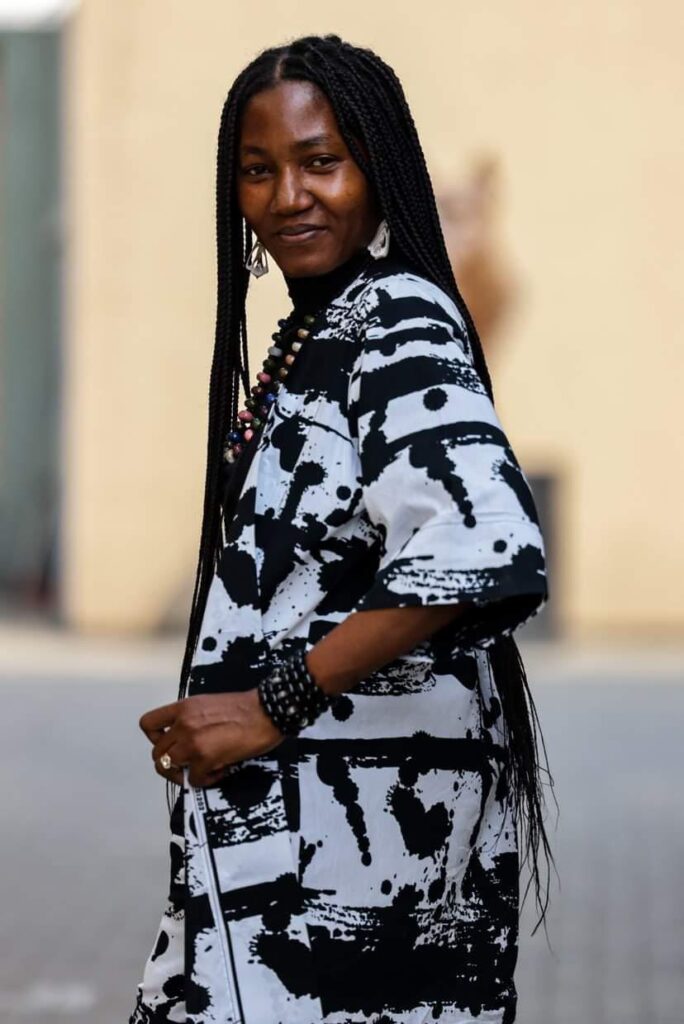
I would say that I am privileged to have a mother and father who accept me for what I want to do. When they realised that I could draw, my teacher in primary school saw my drawings and said I should go for art. After secondary school, I didn’t make my WAEC, so I was at home.
One day, my brother told me he saw a school around where they were teaching art, fashion, and textiles. He took me there, and I started. It’s an institution of technology. It was because they saw the gift in me, and they didn’t want me to just be at home. It was the teacher there who filled out my JAMB form. He insisted that I study fine-art education. I said I didn’t want to be a teacher because education is for teachers. He said that I might not understand it at the point, but I’d understand as I grow.
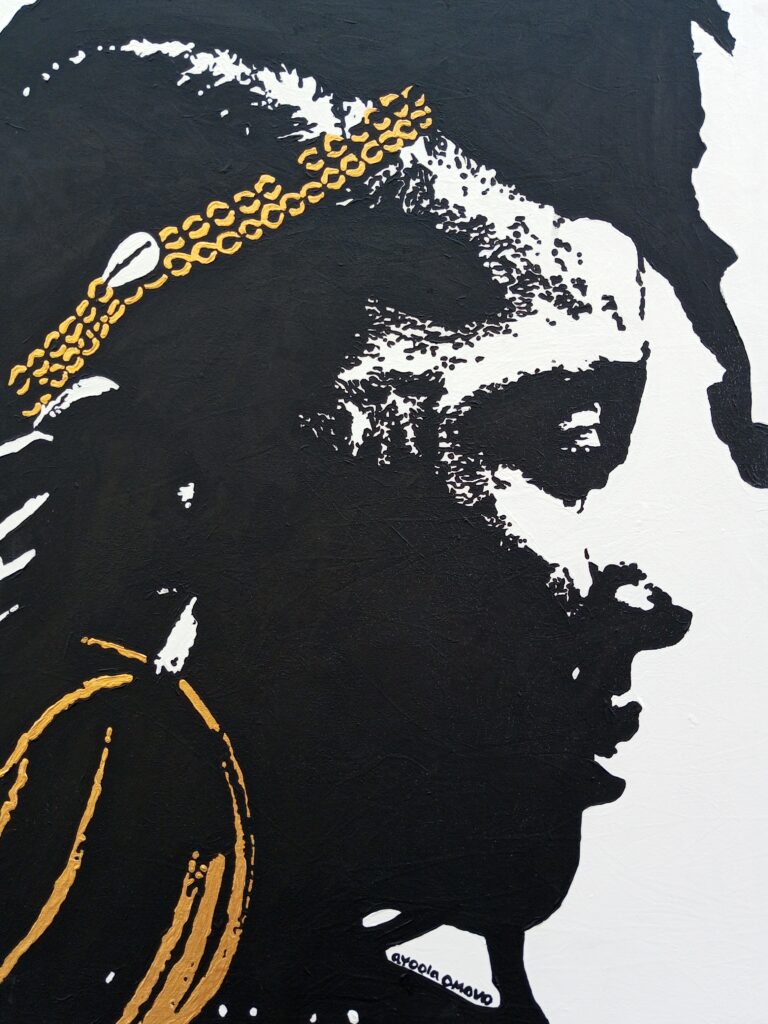
I gained admission to the University of Benin, and I was shuffling between the two campuses. I studied education on the main campus and art on the second campus. I learned the psychology of teaching and how to treat and relate to children. It exposed me more to teaching and how to get people’s attention. Even when you’re not an artist, I can take you into scribbling art, where you will love what you’re doing; therapeutic art, which you’ll just enjoy. Before you know it, you’ll see something in what you’ve drawn. Art is fun, and it is something you must have a passion for. Gradually, it extends, and you become an artist.
I would say that I give it up to my parents, who gave me the privilege to study art. Today, they are proud. When I left for school, there was one particular family member who wondered, if I was so dumb that I had to go study art, why would my parents permit me to study art from Lagos to Benin? Today, it’s another story entirely. When those family members see me, they talk about how proud of me they are, but they can’t tell me what they said to my parents back then. They see value in it now.
Not everyone will study sociology, medicine, or engineering. We should see beyond tagging artists as being rough, rugged, or not intelligent. The story is that they communicate with you. They give you a message, they speak out their voice, and it helps the economy of the country itself. A lot of people are coming to Nigeria. Festa ‘77 was the largest gathering of the whole world coming to Nigeria, Africa. We’re still planning such a thing if we get the support of the government and other people. Contemporary art and African art are what are in vogue. In all the art fairs happening in Berlin, New York, and everywhere all over the world, they are still craving African art.
More Like This:
Fashion and lifestyle products can add a lot of value to your life!
Getting Better Wine For Better Value?



